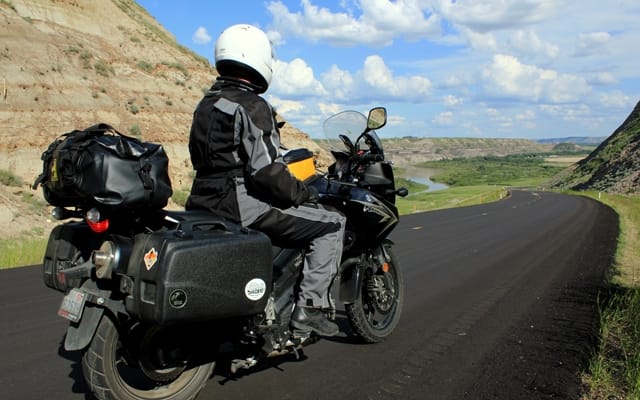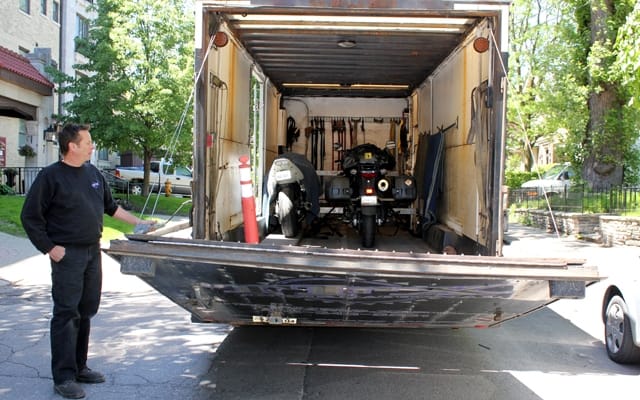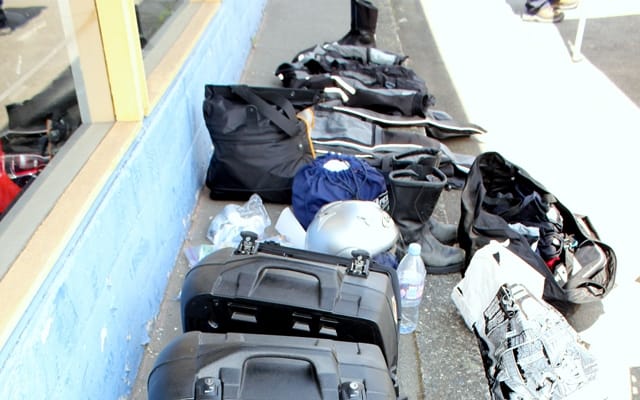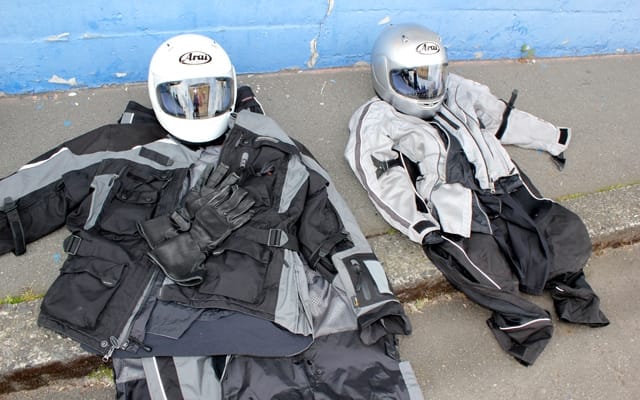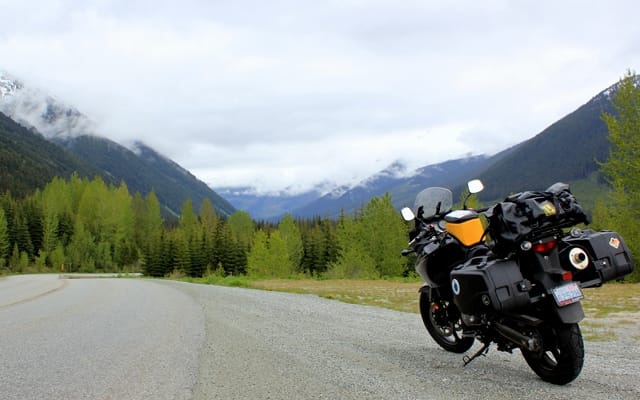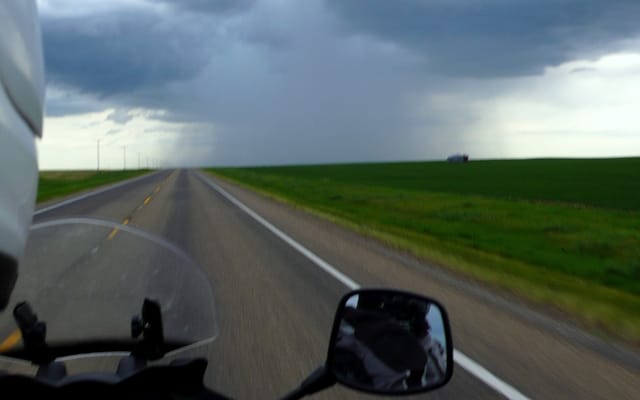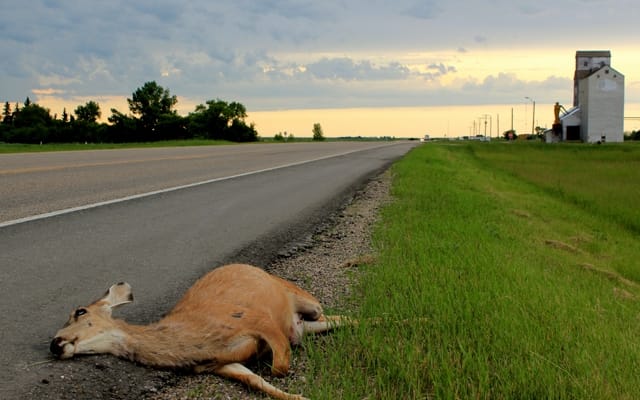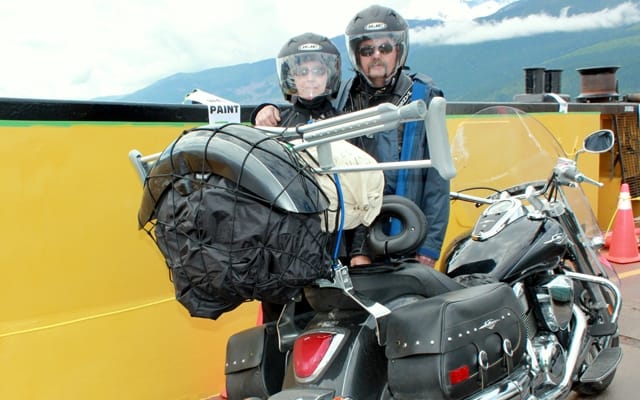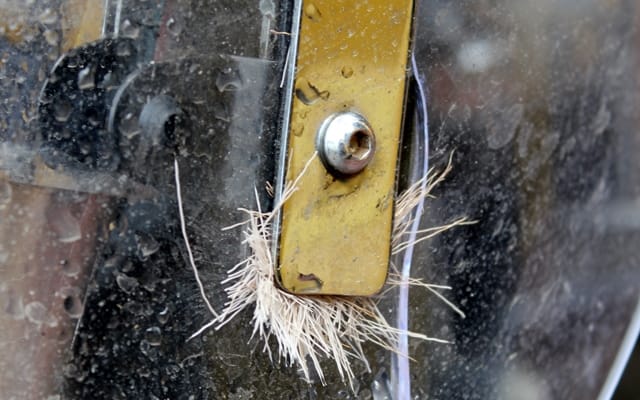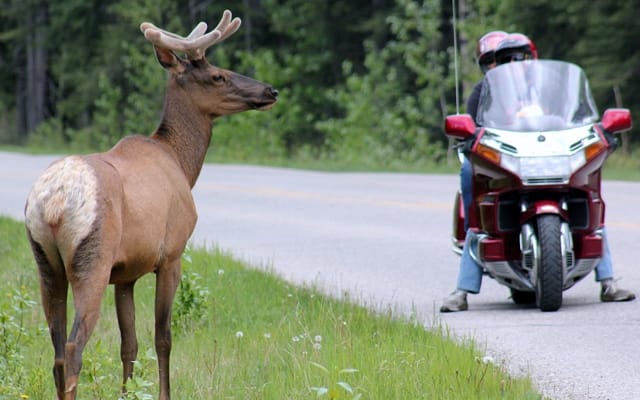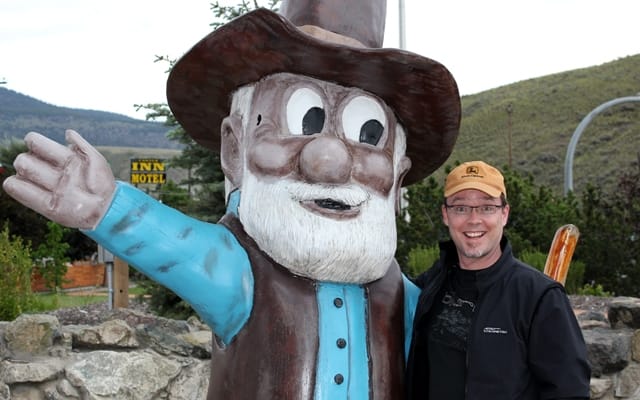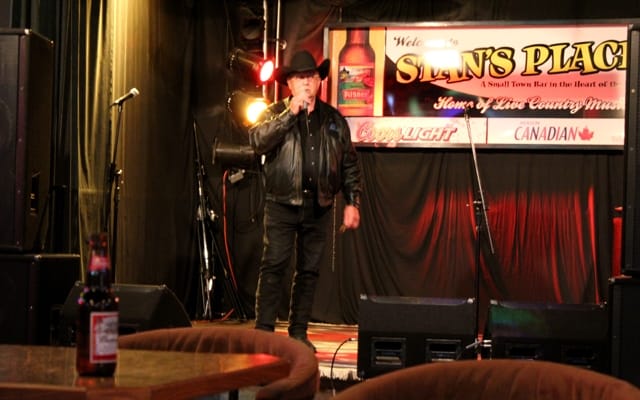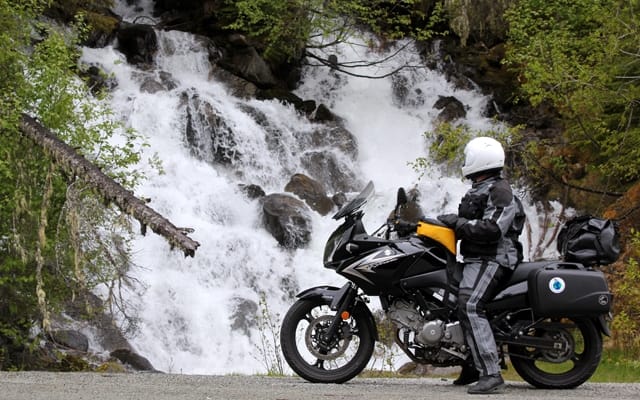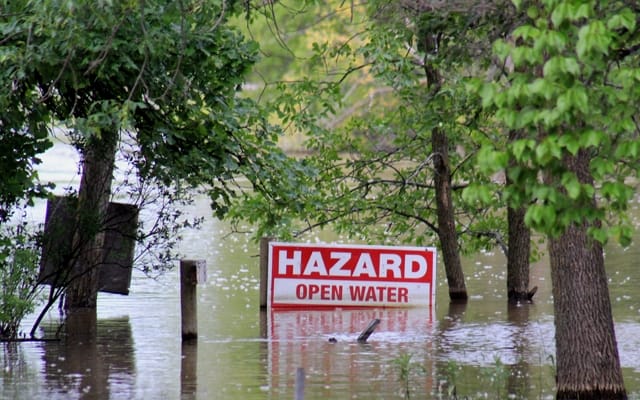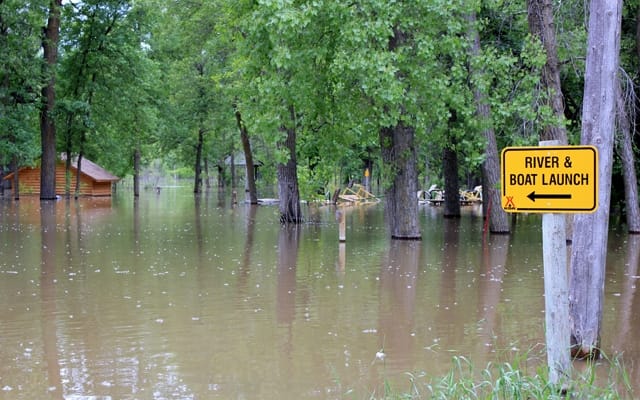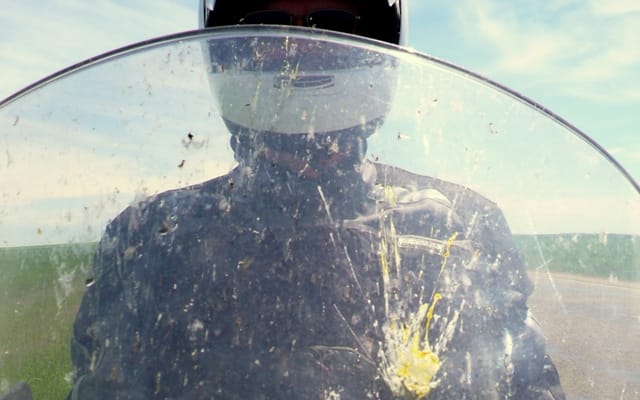Paul Bremner and Lana Munjas rode across the Prairies during the stormiest spring on record. Canada was not amused.
Midway through our summer vacation, the realization hit me like a lightning bolt: Canada was trying to kill us. It was a logical conclusion, given that an actual lightning bolt had struck a field to our immediate left just a moment earlier. It was Saskatchewan in June, and Lana and I, riding two-up from Drumheller to Saskatoon, were caught up in a weather system of biblical proportions.
The grey mass had rolled over the prairie sky in less than an hour. When we stopped for lunch in Alsask, Saskatchewan, the skies were mostly clear. By the time we paid our bill, lightning was flickering to the west and south. The rain began almost as soon as we suited up.
Being a coddled city dweller from Toronto, and therefore unfamiliar with prairie weather, I assumed we could ride through the rough stuff and pop out into blue skies on the other side. I was wrong. The system became a monster, spawning multiple storm cells; we could see them now, drifting across the open land on both sides of us, scouring the earth with sheets of rain.
At first, Highway 9 led us around and between the cells. It seemed like a miracle: Each time we headed straight into the maelstrom, trusty number 9 bent the other way. “I love this road!” I shouted in my helmet.
Then, as if sensing our presence, one particularly massive cell began to slide towards the road ahead of us. I opened the throttle, hoping to run past it, but it was too big and moving too fast. We pulled over to the shoulder, watching as passing cars and trucks disappeared into the murk.
After a while, the storm gave up and moved off the road in search of new victims. We pressed on, wincing as lightning bolts sizzled to the ground in the storm’s wake. There was no more rain, but with every passing mile the clouds seemed darker and heavier, as if weighed down by some invisible cargo. As we passed under one, a great grey zeppelin that seemed low enough to touch, hail began to fall, rattling off our helmets and stinging my knuckles through my thick leather gloves.
A few tense minutes later, we rolled into a Wendy’s in Rosetown and sipped hot coffee while the lights fluttered and the windows shook. Even the locals looked nervous. Giddy from the adrenalin and the caffeine, we wondered aloud what Canada had in store for us next. Because this wasn’t our first hair-raising experience on this trip, and we suspected it wouldn’t be the last.
It had started as a relaxed ramble across our western provinces. Having some business in Vancouver, my wife Lana and I decided to ship our Suzuki V-Strom 650 out west, then ride home. There would be no big-mileage days. We’d give ourselves two weeks, and take the back roads whenever possible.
We hired TFX International to do the shipping, a company that specializes in transporting vehicles. The procedure was simple and confidence inspiring. The driver, an off-duty firefighter, arrived at our home with a trailer, tied the bike down, took our money, gave us a receipt, and drove off. There was no need to crate the bike or drain the gas tank. The only hiccup was a price difference between the original quote and the total, which meant having to give the driver about $20 in coins from our laundry jar. TFX later owned up to the error and refunded the money.
On departure day, we picked up the bike from North Shore Yamaha-Suzuki in Vancouver and packed our gear. We’d neglected to try this at home first, and it felt like we’d brought way too much stuff. Looking at the gear spread out across two parking spaces, dealer manager Mike McCaffery quipped, “Are we having a garage sale?”
With gear finally stowed and suspension adjusted for maximum load, we rolled up the Sea-to-Sky Highway to Whistler, then followed 99 past Pemberton. This was the rightly famous Duffey Lake Road, long revered as one of Canada’s most exciting motorcycling routes. While the Sea-to-Sky had largely been tamed by pre-Olympics construction, 99 still felt wild and free, winding its way through the coastal mountains and over the Cayoosh Pass at 1,275 metres.
The road seemed custom-made for motorcycling, a thrilling combination of high alpine twists, tight canyon switchbacks, and snaky river sections interrupted by single-lane bridges. We crossed over the coastal mountains and into the arid heat of B.C.’s Cariboo region, spending the night in Cache Creek.
The plan was to loop south of Kamloops along some twisty secondary roads, then head up to Revelstoke. But a few miles down the road the plan changed. In Ashcroft, we came across a fairgrounds packed with horse trailers and cowboys — a rodeo in the making. We were too early for the show, but Carol, the rodeo organizer and herself a motorcyclist, took an interest in our trip. She insisted that we detour down into the Kootenays, across the Monashee mountains to the Arrow Lakes. “The best ride in the area. Just amazing,” she sighed.
Following her advice, we set off on Route 97C, south towards Logan Lake. Not 10 minutes later, as the road climbed into the hills, Lana spotted the first deer. She gave me her patented warning signal — a two-handed whack to my kidneys. “There was a deer!” she shouted over the roar of the wind. “Didn’t you see it? It was standing right by the side of the road!”
I hadn’t seen it. I was enjoying the road too much, and the brown scrub brush lining the road was very deerish in colour.
I reduced my speed and the deer count began to rise. One in a gully, wide-eyed and ready to jump. Three gathered on the road as we crested a blind rise. Two on this side of a farmer’s fence, mulling their next move. All mule deer: big, strapping animals that made Ontario whitetails look like poodles.
The deer sightings continued all the way to Nakusp on the east side of Upper Arrow Lake. As the day wore on we became the skittish ones, ready to bolt or brake at the first sign of movement in the bushes. We called it a day then and there, unwilling to chance the road to Revelstoke in the growing twilight.
Our fears were validated the next morning. On route 23 to the ferry at Galena Bay — another bit of Kootenay motorcycling heaven — we passed a couple on a Suzuki cruiser, chugging along at a snail’s pace. A fender and a pair of crutches were strapped to the back of the bike. Once aboard the ferry, the rider, Dave Strong from Sherwood Park, Alberta, told us about his encounter with a Kootenay deer.
“We were going around a corner at about 75 km/h, and we saw a deer on the other side of the road,” he said. “I braked, but then the deer took two steps away from us, so I came off the brake thinking she was moving off the road. Then she turned around and jumped right in front of us.”
The deer launched itself onto Dave’s windshield, leaving a trail of shit on the windscreen and clumps of hair buried in the seams of the bike’s front end. The bike and deer went down together, crushing the front fender, and sending Dave and his wife Susan skidding across the road. A passing motorist helped them remove the fender and right the bike, allowing them to limp to a nearby lodge. Fortunately, the proprietor was a former paramedic, and helped them get medical attention. Their injuries were minor: a sprained thumb and bruised ribs for Dave, and a possible fractured tibia for Susan. It could have been much worse — Susan’s visor carried deep gouges from her face-first slide across the pavement.
Dave, a life-long motorcyclist, was clearly rattled but determined to ride back to Edmonton. He left us with a few words of caution: “Don’t try to judge what a deer is going to do. Just slow down.”
Leaving the Kootenays, we saw fewer deer. We reached tiny, perfect Revelstoke without incident, then climbed through the cloudy Selkirk range to find Rogers Pass enveloped in sunshine at 1,300 metres. We continued on to Lake Louise, until, driven mad by the hordes of tourists, we took the advice of a fellow motorcyclist and left the Trans Canada to take the Bow Valley Parkway to Banff — a spectacular, if slow-moving, wind through evergreen forests under the shadow of Castle Mountain.As we rode,I found myself resenting Calgary motorcyclists. This road was only 90 minutes from downtown Calgary. To a flatlander, it hardly seemed fair.
At one point, traffic slowed to a halt as motorists stopped to photograph a pair of elk. I felt my blood pressure rise as a few tourists walked right up to the animals to take cell phone photos. I secretly hoped for a “When Animals Attack”-style elk rampage, but no such luck.
From Calgary, our route should have taken us back south to Grasslands National Park in Saskatchewan, then along the border all the way to Steinbach, Manitoba. But it was not to be. A heavy snow pack and record rainfall had combined to create flooding throughout the southern prairies. Even a section of the Trans Canada east of Regina was closed. I called the Saskatchewan roads department, and the nice lady on the phone didn’t mince words: “Do not travel to the southern Saskatchewan.”
We decided to change course, opting to visit the badlands and dinosaur fossil beds of Drumheller, then ride on to Saskatoon and keep our date with the mother of all storms.
We emerged from the storm in the early evening, arriving at our Saskatoon B&B wet and tired. It was a lovely house in what seemed like a not-so-lovely inner city neighbourhood. When we asked our host about a place for a cold beer and a hot meal, he directed us to a sports bar down the street.
Stan’s Place wasn’t exactly what we expected. It was more than a bit rough around the edges, and permeated with the sour beer smell that marks the hard-core drinking establishment. A row of slot machines was visible beyond some western-style swinging doors at the back of the room. The patrons were a mix of young aboriginal men in hip- hop outfits and elderly cowboys in jean jackets and Stetson hats. The waitress gave us a strange look but took our order anyway.
As the evening progressed, Stan’s turned out to be an unexpected treat. It was “country karaoke night,” a weekly event broadcast live on a local AM radio station. Two or three of the singers were very good, inspiring Gordie, an old cowboy sitting next to us, to invite Lana for a few spins around the dance floor. A few of the drunken regulars turned in memorable performances, including Stan’s off-duty cook, whose high-pitched warble suggested a tone-deaf Tammy Wynette.
Two steaks and a few beers later, we stumbled home in the rain, happy for the experience. It was only the next morning that we learned we went to the wrong bar. Stan’s had been the scene of several serious violent crimes, including the 2010 murder of a member of Saskatoon’s infamous “Terror Squad” gang. When our host heard we went to Stan’s he turned pale and clapped a pudgy hand to his forehead. “Oh, geez! You went to Stan’s? Boy you’re lucky it wasn’t a Saturday night!”
Feeling a bit woolly-headed, we rode past Stan’s and out of Saskatoon, heading east along Route 5 instead of the busier Yellowhead Highway.
The landscape was gently rolling, and dotted with stands of trees. The constant rain had delayed spring planting, and infused the fields with a bright, almost emerald green. Curiously, there were few signs of human activity. The farms were so large that the distance between houses and barns could be measured in kilometres. The quiet landscape and arrow-straight road made for a relaxing, almost meditative riding experience.
The road led us through Humboldt, Englefield, and Quill Lake. The faded storefronts and greying townsfolk provided a noticeable contrast to the lush countryside. These middle prairie towns had seen better days. Hoping for a home-cooked meal, we stopped for lunch in Wadena, billed as “The hometown of Pamela Wallin.” I ordered the chicken soup. “Do you make it here?” I asked. “It’s Campbell’s frozen,” the waitress said. “Tastes good, though.”
You might expect home made soup in a country town like Wadena, but fresh food was surprisingly hard to find in many of the prairie communities we visited. There were few farmers’ markets, and, other than the berries in saskatoon berry pie, little evidence of local produce in restaurants. It might have been the weather or the time of year, but I suspected something else. Most agriculture here seemed focused on commodities like corn, wheat, and canola. The breadbasket of Canada was set upto feed Cargill grain silos and not diners in Wadena.
Still rattled by yesterday’s storm, we kept a close eye on the weather. A farmer in Alsask had recommended an iPhone app called “Canada Radar,” and I referred to it frequently, checking conditions ahead and behind us. We made it to Yorkton in the nick of time. Just fifteen minutes after we checked in to our hotel, yet another storm erupted, flooding city streets and bending saplings horizontal with gusts of wind. The filthy V-Strom, nestled between two cars, enjoyed an impromptu pressure wash. Within 15 minutes, the storm abated and the temperature turned scorching. As the sun set, the massive cloud formation, a floating fortress in white, drifted into the distance. Although I’d learned a whole new vocabulary for storm clouds in Saskatchewan (“hammerheads,” “wedge clouds”) I had no name for this one.
Canada’s weather tantrums stopped in time for our crossing into Manitoba. We took the Yellowhead Highway southeast, moving closer to the flood zone. Many of the farm fields were flooded, filled with families of ducks instead of rows of wheat. The entire region looked like a wetland; sometimes the only way to distinguish field from lake was by the odd fencepost or telephone pole peeking above the water. In this region, some farmers have endured three consecutive years of flooding.
With the standing water came insects. Manitoba has a reputation for mosquitoes, and they came at us in droves. But there was more. On the road into Dauphin, clouds of huge black flies floated through the air like big, sooty snowflakes. They were evil-looking creatures, with whip-like antennae, large wings and hooked legs. I hate creepy-crawlies, and quickly snapped my visor closed, shuddering at the thought of sharing a helmet with one of those monsters. They bounced off my helmet and gloves with pebble-like cracks, except for one, which floated over the lip of my windshield and was somehow sucked down into the general vicinity of my crotch. I found half of him later that day, wrapped around one of my brake cables.
By the time we hit Neepawa, my riding suit was an entomologist’s delight. Gone was the usual road trip bug splatter; in its place were wings and legs, heads and thoraxes, and gobs of yellow, viscous goo. I apologized profusely to the owner of our lovely B&B, and tried very hard not to touch anything on the way up to our room.
After four days of Prairies riding, I was looking forward to the rugged landscape of the Canadian Shield. Although I was born and raised in southern Ontario, I thought of the whole province as home. But a quick check of Canada Radar that morning made my heart sink. Another fast-moving system was moving in from the west. We decide to blast along the Trans Canada and get to Kenora as quickly as possible.
It proved to be ugly riding, with grey skies and grey pavement providing the only scenery. We bypassed Portage la Prairie and then Winnipeg, exiting the ring road around the city like a rocket escaping orbit. We stopped for bowls of split pea soup at Ste. Anne, a francophone town at the edge of the prairie, then rode on through the gathering gloom.
A few minutes later I felt one of Lana’s familiar kidney punches. I looked around for a deer but saw nothing. She shouted at me to stop, and quickly hopped off the bike when I did. “It’s my stomach,” she said. “I think it was the soup.” In obvious pain, she speed-walked off the Trans Canada and into the bush, re-emerging a few minutes later, pale, sweaty and covered in blackfly bites. By that point I was feeling a bit grim myself, and my belly had started making some disturbing noises. We rode off again, hoping to get to a hotel before things got worse.
A fragment from a long-ago philosophy class intruded on my thoughts: “As above, so below.” With our bowels turning to water, the heavens unleashed a deluge, soaking our boots and our gloves,and shrouding the highway in a cloud of fine spray. I turned my heated grips on high, gritted my teeth, and started counting down the 88 kilometres to Kenora.
We found an inexpensive motel room next to the jail. It was slightly shabby, but clean and spacious enough for us to spread out our soggy gear. We hunkered down for two days, sleeping, reading, and waiting for the storms to pass. By this time we had figured out what any western Canadian knows intuitively: all weather systems move west to east. If you’re travelling west, you can punch right through them. If you’re travelling east, bad weather can follow you for days.
Our patience was rewarded. The next four days each dawned bright and sunny, and stayed that way. Kenora to Thunder Bay. Thunder Bay to Wawa. Wawa to Blind River. And finally, Blind River to Toronto. No suicidal deer threw themselves under our wheels, and the mosquitoes, while still horrible, were at least tolerable. Even the legendary northern blackflies weren’t all that bad, save for the one little bugger that buried itself in my helmet liner and feasted on the scalp behind my right ear. The black clouds that had been following us — both real and metaphorical — were finally gone.
The friendly weather was well timed. This section of the Trans Canada, particularly the stretch south of Wawa, provided some of the trip’s most memorable riding, and we revelled in the spectacular scenery of the Lake Superior shore.
Gassing up one last time outside of Orillia, Lana and I were all smiles. Looking back on our experiences, we understood them to be a kind of rite of passage — the price paid for experiencing the cold, wild beauty of our western provinces. There was no hand of doom trying to wipe us off the road. Canada wasn’t trying to kill us.
Noticing our happy expressions, a kind-looking old man approached us. He looked at me intently and said,“Are you ready to meet Jesus?”The question caught me off guard. I hesitated, then blurted out the first thing that popped into my head: “No, thank you. Not today.”
